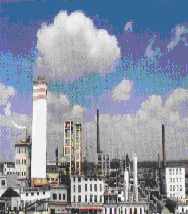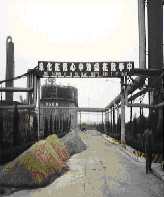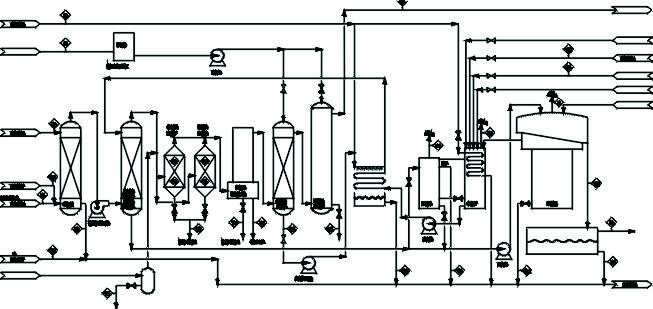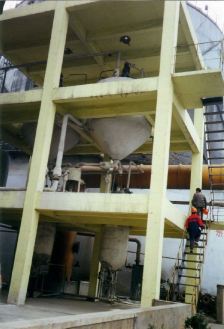


Case Studies
| This case study was prepared by the China Canada Cooperation Project in Cleaner Production |
A Cleaner Production Success Story
June 1999
Summary
Introduction
The
Business Case for Cleaner Production
Fuyang:
The Road to Success - Project Description and Participants
Approach
Used in the Cleaner Production Project
Preparation
of Process Flow Diagrams
Example
Process Flow Diagram
Sampling
and Flow Measurements
Water
and Material Balance
Development
of CP Solutions
List
of Clean Production Measures
Table
1 - List of CP Measures
Implementation
of Medium Costs CP Solutions
Accomplishments
and Rewards Benefits
Management
Commitment and Employee Empowerment/Participation
The
Role of Policies and Guidelines
The
Role of Information Technology
The
Role of Training
Gender
Equity
Sharing
the Success Story - The Wider Impact
Conclusions
Summary
Employees and management have readily adopted Cleaner Production (CP) concepts at the fertiliser plant of Fuyang Chemical General Works. The plant, located in Fuyang City in Anhui Province of China, produces ammonium bicarbonate and urea fertilisers.
|
|
In a project funded by the Canadian International Development Agency, Canadian engineers, process specialists, and others worked closely with the State Administration of Petroleum and Chemical Industries and Fuyang plant personnel to develop practical no and low cost solutions to improve productivity and profitability and to reduce pollutants. The project started in 1996 and has focused on minimising water consumption, efficient use of raw materials and energy, recycling of materials, improved housekeeping, and careful and safe handling of raw materials, intermediate products, and finished goods. In the first full year after implementing many of the no and low cost solutions, the company realised an increase in production of three percent, while saving 15 Million Renminbi (CDN$ 2.8) by picking so-called 'low hanging fruit'. Credit goes to the employees who quickly rose to the challenge and embraced the principles of CP. Equal credit goes to management who fully committed to the program and indeed challenged and empowered employees to find solutions who were then rewarded for their initiatives and successes by bonuses.
China's leaders have given Chinese industry notice that it must become more productive, that it must improve its profitability, and that it must reduce the mass loading of pollutants that it emits to the environment. Failure to do so means plants being closed. Pressure to improve is even more intense in important river basins such as the Huai He. Canada has committed to help Chinese industry by launching a five year CDN$ 9,000,000 project to provide assistance for Cleaner Production in four industrial sectors, one of which is the fertiliser industry. Funding for the China-Canada Co-operation Project in Cleaner Production is being provided by the Canadian International Development Agency (CIDA). Major Canadian participants in the project include: PricewaterhouseCoopers LLP, SNCw Lavalin Environment and ESSA Technologies. Chinese partners include the State Economic and Trade Commission (SETC) which is the Chinese Executing Agency, the State Environmental Protection Administration (SEPA), the Anhui Provincial Economic and Trade Commission (AHETC), the State Administration of Petroleum and Chemical Industries (SAPCI), and the State Bureau for Light Industry (SBLI). Strong support and encouragement also came from the Governor of Anhui Province and the Mayor of Fuyang City. Management of the Fuyang Chemical General Works fertiliser plant in Fuyang, Anhui Province agreed that their plant would be the demonstration site for Cleaner Production for China's fertiliser industry.
The Business Case for Cleaner Production
The United Nations Environment Programme (UNEP) defines Cleaner Production as "the continuous application of an integrated preventive environmental strategy applied to processes, products, and services to increase eco-efficiency and reduce risks to humans and the environment". UNEP also states that, in production processes, "this means conserving raw materials and energy, eliminating toxic raw materials, and reducing the quantity and toxicity of all emissions and wastes".
UNEP goes on to state that: "Cleaner production requires changing attitudes, responsible environmental management and evaluating technology options. Other preventive approaches, such as eco-efficiency and pollution prevention, serve similar goals." And that "Much of the current thinking on environmental protection focuses on what to do with wastes and emissions after they have been created. The goal of cleaner production is to avoid generating pollution in the first place - which frequently cuts costs, reduces risks and identifies new opportunities. Cleaner production can be the most efficient way to operate processes, produce products and to provide services. Costs of wastes, emissions and environmental and health impacts, can be reduced and benefits from these reductions and new markets can be realised."
Thus, cleaner production concepts are really just a sound business approach which, when implemented, reduce production costs and increase profitability. The plant becomes more competitive in the process, while at the same time reducing environmental impacts, risks and potential liabilities.
Fuyang: The Road to Success - Project Description and Participants
The project to implement cleaner production at the Fuyang Chemical General Works fertiliser plant is one of two demonstration projects under the China-Canada umbrella project. The fertiliser CP program started with a review of four (4) plants including that of Fuyang Chemical General Works. The latter was chosen as the demonstration site. Among key features of this fertiliser plant were profitability and commitment from management to becoming more competitive and profitable while being better able to meet the pollution standards that were being imposed.
|
|
SNCw Lavalin Environment of Montreal, Canada and the engineers at the Environmental Protection Research institute of the Bureau of Chemical Industry, in Beijing, PRC, provided the process and engineering input to assist Fuyang company management and plant staff to move quickly and successfully towards implementing cleaner production. The interface between (a) plant management and staff and (b) the Canadian and Chinese engineers was critical. From the outset professional and personal relationships developed which translated into quick implementation of alternatives supported with enthusiasm by all participants.
Many other entities have been, or continue to be involved in the Fuyang location and in the wider scope of the project. Their roles and contributions, and their impacts on the project, are described elsewhere in this case study.
Approach Used in the Cleaner Production Project
Once the plant was chosen, engineers and process specialists from SNCw Lavalin in Montreal as well as from Beijing undertook an on-site cleaner production audit with full participation of plant process and manufacturing staff.
Preparation of Process Flow Diagrams
The basic methodological step in the Clean Production (CP) audit was the preparation of the Process Flow Diagrams (PFDs). PFDs are the key to developing clean production solutions. Twenty-eight PFDs were developed for the Fuyang Fertiliser Plant as part of the CP Audit. Each of them describes a specific unit process, including all major pieces of process equipment (pressure vessels, reactors, scrubbers, coolers, pumps, etc.), and process streams. Using the engineering information from the PFDs, it then became possible to systematically assess the environmental emissions (liquid effluents, air emissions and wastes) from every pieces of process equipment. On this basis, a detailed list of all environmental emissions was prepared, indicating the sources (i.e. equipment number), the nature (stream number), the point of discharge, the general composition and the frequency (e.g. continuous emission, intermittent emission, blow downs, periodic from maintenance, etc.)
Example of Process Flow
Diagram
Prepared during the Process
Audit
|
|
Sampling and Flow Measurements
The preparation of Process Flow Diagrams was the basis to first identify the sources of environmental emissions from the ammonia/urea manufacturing process, and second to select the major streams (emissions) to be included in the field sampling program.
Sampling points were selected based on the PFDs. They included sampling at the source (process equipment) as well as at various locations along the sewer network. In addition to taking samples, flow measurements were carried out at each of the sampling points. Samples were all analysed at the plant laboratory or using a portable laboratory.
The PFDs and the results from the sampling program then lead to the third methodological step in the CP audit, which is the development of the water balance and pollution loads analysis.
The ultimate information which is brought to light from this step of the CP audit is the priority process areas and priority process emission streams for which CP solutions will have to be developed.
In the case of the Fuyang Fertiliser Plant, the above CP audit resulted in clearly identifying two (2) priority process areas and seven (7) process streams which were responsible for up to 60% of the pollution due to the losses of ammonia to the air and to the sewer.
Not only do the losses of ammonia to the atmosphere and to the sewers result in a major pollution problem (ammonia is highly toxic to the aquatic life and depletes oxygen in the receiving water bodies), but they also represent a loss of revenues to the plant. Since ammonia is the main finished product manufactured by the plant, losses to the air and to the sewers turns out to be a loss of revenues as well.
Under the CP audit, it was estimated that millions of RMB were wasted to the sewers by the losses of ammonia from the priority process areas identified by the audit. This became the basis for developing Clean Production measures which would target the two priority process areas and the seven (7) priority process streams.
List of Clean Production Measures
Having clearly identified the seven (7) process streams (sources of pollution) which accounted for up to 60% of the ammonia losses, the SNCw Lavalin, SAPCI and Fuyang Plant engineers went back to the Process Flow Diagrams and used them to study alternative schemes to recycle and/or recover these streams. In order to assess the technical feasibility of some of the CP solutions, state-of-the-art computer process simulation models were used by the Canadian and Chinese Engineers. The list of CP measures which were studied and implemented is presented in Table 1.
The set of CP measures were all targeting the priority sources of ammonia losses to the environment (up to 60% of total losses). In addition, the Fuyang Plant also developed and implemented six other zero and low cost CP measures in various areas of the plant operation:
-
Elimination of broken fertiliser bags on the ground at the storage area. This measure results in considerable reduction of the contamination of storm run-off by nitrogenous compounds.
-
Generating revenues from wastes. Installation of a new settling pond at the power plant to improve the removal of suspended solids from the stack scrubbing liquor. This measure also resulted in increasing the revenues from selling settled solids as a material for various construction applications under Chinese practices.
-
Maximising oil recovery for recycling and reuse. New equipment were added to recover oil from the process gas following gas compression.
-
Preventing leaks of copper solution from storage tanks and filter-presses. This measure resulted in savings on the cost of chemicals (copper solution) in addition to eliminating the contamination of water with chemicals.
-
Aesthetic site improvements. Cleaning of a dump area and conversion into a garden.
-
Minimising the discharge of wasted oils by manual recovery of free oil from the sewers.
Fuyang General Chemical
Works
List of CP
Measures Implemented
under the Canada-China Cleaner Production
Project
|
Stream |
Stream Identification |
CP Measures |
Goal of CP Measure |
Cost Category |
|
1 |
Air emissions of ammonia from the mother liquor tanks |
Collect air emission; and direct to a wet scrubber |
Reduce atmospheric emissions. |
Low cost |
|
2 |
Air emission of ammonia from the bagging operation |
Ventilation, air collection and scrubbing of the air at the wet scrubber |
Reduce atmospheric emissions. |
Low cost |
|
3 |
Scrubbing liquor |
Recycling at other process unit |
Prevent discharge to sewer |
Low cost |
|
4 |
Bleed from integrative tower |
Recycling at other process unit |
Prevent discharge to sewer |
Low cost |
|
5 |
Bleed from CO/CO2 trace removal |
Recycling at other process units |
Prevent discharge to sewer |
Low cost |
|
6 |
Bleed from isobaric absorber |
New equipment for the concentration, recovery and reuse of ammonia |
Prevent discharge to sewer |
Medium cost |
|
7 |
Supernatant from sulphur wastes at the gas desulphuri-sation area |
New equipment for the recovery of sulphur, extraction and recycling of diluted ammonia |
Convert sulphur wastes into saleable
products |
Medium cost |
|
8 |
Ammonia condensate from the collection of contaminated air at the bagging area |
Manual collection of the condensate before it reaches sewers; return to recovery |
Prevent discharge to the sewer |
Zero cost |
Implementation of Medium Costs CP Solutions
The China-Canada CP Project provided financial support to the implementation of two medium costs CP solutions. These are the CP measures Nos 6 and 7 in Table 1.
|
CP Solution Implemented at the |
|
|
Following a joint recommendation by the Chinese and Canadian technical teams, the implementation of these two CP solutions was carried out as per the following steps:
-
Engineering and equipment specification in a joint work by the Canadian and Chinese Technical Teams.
-
Cost estimating for equipment, civil, structural and electrical by the Chinese Technical Team.
-
Preparation and issuing of tender documents for the fabrication of equipment.
-
Selection of bids and purchasing of equipment.
-
Civil, structural and electrical work at the plant by Fuyang personnel.
-
Mechanical installation by Fuyang plant personnel.
The two (2) CP solutions are currently fully installed at the Fuyang Plant. As of now, they have reached the final stages of commissioning.
Accomplishments and Rewards Benefits
CP measures Nos 1 to 6 in Table 1 were not separate action items. Indeed, they are all integrated into one global scheme for pollution reduction at the source. The estimated benefits resulting from the implementation of these CP measures are considerable:
| Total reduction of ammonia losses to the environment (air emissions and liquid effluents) |
4 500 tons/year |
| Total estimated net revenues generated from the recovery of the ammonia losses |
3 Million RMB/year |
The CP measure N° 7 in Table 1 also resulted in substantial benefits:
| Total estimated reduction of ammonia losses to
the environment |
250 tons/year |
| Total estimated net revenues including both
ammonia recovery and sale of recovered sulphur |
0.4 Million RMB/year |
Management Commitment and Employee Empowerment/Participation
Successful implementation of cleaner production happens when good management practices are in place which are coupled with a well operated and maintained plant that operates energy efficiency programs and programs to reduce the use of resources and waste. It is always the case that full commitment of management and the buy-in by operating staff are key ingredients to success. The Fuyang Chemical General Works demonstrated just how much impact this has had on the success of the project. From the outset Fuyang management were enthusiastic and fully committed to this project.
The Role of Policies and Guidelines
One element of the overall project included the involvement of Canadian specialists in environmental policies, regulations and guidelines working with Chinese government agencies and cleaner production centres, and staff from Fuyang, to ensure that these necessary elements were incorporated into the project. These Canadian specialists provided an insight into how Canada has been successful in joint industry-government initiatives to develop policies and regulations that encouraged successful implementation of CP concepts in Canadian industry while at the same time reducing the discharge of pollutants. They reviewed China's environmental regulations and policies with respect to CP (including barriers to implementing CP) and made recommendations that, when put in place, would encourage the move to CP.
As well, the China-Canada CP Project resulted in the preparation of a new Clean Production Guidelines for the ammonia/urea industrial sector. This guideline provides a practical tool to the Chinese fertiliser industry for carrying out clean production process audit and for developing and implementing clean production measures.
The Role of Information Technology
Another
element of the China-Canada project includes installing a computer in
Fuyang with linkages to the project Web page. This enables the factory to
link up with Cleaner Production centres and centres of expertise in China
and around the world. This computer will also be used to store and analyse
data taken from the new measuring and monitoring equipment provided to the
plant by the project.
The plant
management and staff have received process improvement training as well as
detailed on the job training from our Canadian team members. Several plant
managers have also participated in technical study tours to
Canada.
The Canadian International Development Agency (CIDA) has a Gender Equality Policy that requires all its projects "to support the achievement of equality between women and men to ensure sustainable development". The CP Project therefore includes special efforts to promote women’s participation in all project training programs and within the Project’s partner agencies and enterprises. The project is achieving its target of 30% women in all its training programs.
A Local Gender Equity Consultant is working with project counterparts in Beijing, Hefei and at Fuyang to raise awareness about gender issues and to promote gender equity. Workshops discussing reasons for the lack of women at management levels in the factory have generated a great deal of interest. A national workshop on Gender Equity and Development was held in Beijing to discuss gender issues in the workplace. As a result, a new NGO was created called the Women and Environment Network (WEN), with the objectives of publicizing gender and environment issues and undertaking activities promoting environmental awareness. The leaders of this group will be extending the Network to the provincial and factory levels through a second Gender and Development Workshop in Hefei.
Sharing the Success Story - The Wider Impact
The project to implement cleaner production at Fuyang has been a success story as evidenced by the benefits described above. Fuyang management have agreed that they would share this information with other industries in China and elsewhere so that others might speed implementation as well. Some examples of how this success story might be shared include planned publication of this case study in Chinese and English on the project web site.
With the close involvement of SETC, SEPA, other state ministries, AHETC, and other organisations many opportunities exist to distribute the case study and ongoing successes to other fertiliser manufacturers in China and to other industry sectors which want to implement or advance their own Cleaner Production programs.
As well, there has been interest in the United Nations Environment Programme (UNEP) through its Paris-based Industry and Environment office to place the case study on its Cleaner Production web site where UNEP accumulates similar success stories made available by other companies. Often, UNEP makes printed copies of these success stories available to attendees in Cleaner Production workshops that UNEP holds in developing countries.
The Canada-China Co-operation Project in Cleaner Production demonstration project at the Fuyang Chemical General Works fertiliser plant in Fuyang City, Anhui Province has truly been a success story. The plant has made important productivity improvements, has reduced production costs, has seen improved energy efficiency, and has reduced the load of pollutants discharged to the environment. This is an excellent example of how a focus on implementing Cleaner Production can make a significant difference. The important elements that make this a success story include: management commitment, employee participation and support, designing a program where the no-cost and low-cost program elements were tackled first to get the most benefits with the least amount of money, training and sharing of information, and partnerships with government agencies and others. Cleaner production program elements will continue to be implemented and management and staff have put in place a continuous improvement (CI) process.
Sharing this success story with others is a logical next step and management has committed to do this.
The Fuyang General Chemical Factory
 |
|
The Fuyang General Chemical Factory |
The Fuyang General Chemical Plant was establish in 1970 as a small-scale nitrogenous fertilizer plant with an annual output of 3,000 tonnes of synthetic ammonia. It is located in Fuyang, Anhui Province. Since 1970 it has expanded both its production and product line and now produces more than 10 chemical products including urea, ammonia bicarbonate, methanol, formaldehyde, high effect water-treating liquid, oxygen, plastic woven bags, etc. The factory now has a work force of 1,600, assets of some 210 million Yuan and a factory site covering more than 160,000 sq. meters. The plant has won many national awards for its environmental safety and its good management, and it has received recognition from the highest levels of government. The factory has received ISO9000 certification and is preparing its application for ISO14000 certification. The factory is investing 430 million Yuan in the construction of a urea/methanol factory. The factory expects to have an annual production of more than 1 billion Yuan.
The factory receives assistance in implementing cleaner production from the China-Canada Cooperation Project on Cleaner Production.
The factory can be contacted by email at fhzc@mail.ahbbptt.net.cn
©SETC 2000-2002



